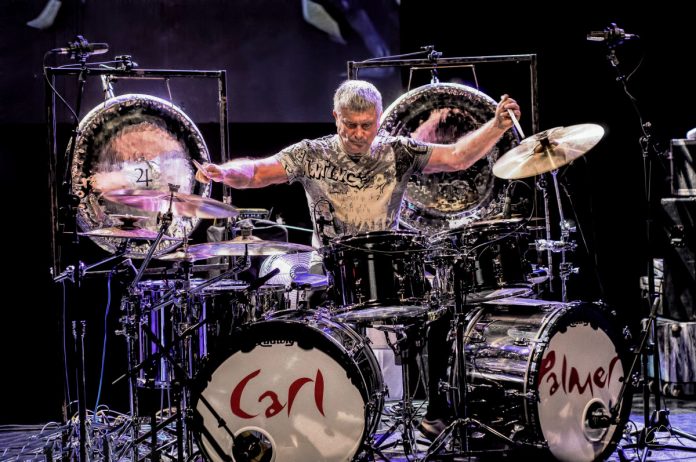HIT CHANNEL EXCLUSIVE INTERVIEW: October 2018. We had the great honour to talk with a legendary drummer: Carl Palmer. He is best known as a founding member of progressive rock pioneers Emerson, Lake and Palmer. He has also been a member of Asia, Atomic Rooster and The Crazy World of Arthur Brown. Carl is touring the world with his own band, Carl Palmer’s ELP Legacy, bringing ELP music to a new generation. In June 2018, they released a new live CD/DVD called “Live”. Read below the very interesting things he told us:
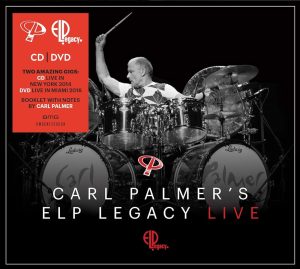 Are you looking forward to beginning the American tour with Carl Palmer’s ELP Legacy?
Are you looking forward to beginning the American tour with Carl Palmer’s ELP Legacy?
Yes, we are just preparing now the interviews for the tour and I have two art events, where I am showing my artwork as well. One of the events will be in Rochester, Upstate New York, so that’s going to be very-very interesting. There are a lot of concerts. We are playing in New York for three nights. There will be quite a lot of dates before the end of the tour. There is something like 24 concerts. Most of the places are small theatres or art centers. There are a couple of rock clubs. So yes, we are really looking forward to it. We are playing music from the new album called “Live”. So, I am very-very pleased about that.
Are you satisfied with the response you got so far from fans and press for the new “Live” CD/DVD by Carl Palmer’s ELP Legacy?
In general, the response was very good. There haven’t been many bad remarks. It’s one of those things: you either like it or you don’t, because I’m not trying to copy ELP. We don’t have keyboards, we don’t have a singer, we are an instrumental group that plays classical adaptations, an instrumental prog rock band, it is slightly harder-edged than ELP were. The DVD with Mark Stein (ed: vocals, keyboards) from Vanilla Fudge and the guitar player we had from Genesis, Steve Hackett and a choir, I think all that worked really well. I’m very happy with the DVD and obviously on the CD, there are different tracks in. You have to understand that the days of prog rock aren’t strong any more. You know, it’s not as big as it used to be. I think it will always be there, because it’s a true art form. In general, yes I’m pleased with what happened and I’m very happy to be with BMG.
The DVD of the “Live” release is from “Pictures at an Exhibition”, a show you did as a tribute to Keith Emerson in Miami in 2016. How emotional was it for you to organize and play that particular show?
It was very difficult because the show was done as a tribute to Keith Emerson, but to be honest with you, in the same year, Greg Lake died, so the show was dedicated to Keith and really Greg, like the album is dedicated to both of them. I have pictures of them inside the CD with me, old pictures from the past. It took a lot of arranging and of course I didn’t think that Greg was going to die in that year. So, when the CD/DVD was going to be released, I decided that we had to change the artwork. When I heard that Greg died, we already had a release date to put it out and I postponed it, I made it later, so I could change the artwork and have pictures of Greg and Keith in there, so I could celebrate both of their lives with the DVD and the CD. So, that’s why it took a little longer to come out.
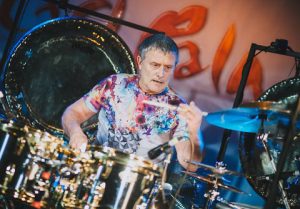 How challenging is it to play the music of ELP without keyboards?
How challenging is it to play the music of ELP without keyboards?
Well, for me it’s a new way. We have a new generation. I ‘ve been going since 2001 and I play to a lot of people around the world and I just wanted to show how versatile ELP music was. ELP music has been played by jazz orchestras, classical orchestras, cover bands and ELP. So, all I doing is taking the music into a different area with virtuoso guitar players. We have a 6-string guitar, a 6-string bass and we use a 10-string Chapman Stick and we can produce all those Moog sounds and keyboard sounds. All I’m trying to do, is bring the music to a new generation of ELP fans. The people between 30-40, now can listen to ELP music and they can make it their own. Obviously, they can listen to the original music and that’s great. But here it is again, been shown in a different field and been played and presented to a new generation.
Do you have any memories of the ELP performance at the Isle of Wight Festival in 1970?
The only real memories I have of that, that I can give you, are very simple: We didn’t see any of the groups play, we were taken in by helicopter, we landed at the back of the stage, we walked on, we played exactly 47 minutes, we walked off the stage and we got back into the helicopter and we got dropped off at our hotel, which was on the island, but it was on the other side of the island, because it was very difficult to move around with all the traffic and the roads weren’t very good. So, we decided that we do a fly-in and fly-out on the same day. I never stayed to see anybody like Jimi Hendrix, Janis Joplin, The Who. We just went in and we came out.
You are responsible for the riff of “Tarkus” and you showed it to Keith Emerson.
I started to play the riff which was in 10/8 or 5/4, however you want to count it and I gave it to Keith and said: “Let’s write some music regarding this” and that’s how we started doing it. So, “Tarkus” was started by me and Keith Emerson wrote the melody on the basis of the rhythmical pattern with the accents that I gave him, which I think that it would work with a melody. He came up with the melody and that was “Tarkus”.
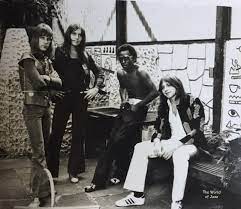 There’s a photo of ELP with Miles Davis at his home in 1971. How did you meet Miles Davis?
There’s a photo of ELP with Miles Davis at his home in 1971. How did you meet Miles Davis?
When we were touring in America, I had a friend who was working for me, he was working for the group actually. He used to take care of the luggage and he was a black gentleman and a very nice man. One day I said to him: “What else have you done in the past? Who have you worked with?” because he was considerably older than we were. He said: “Oh, I have worked with one that you are a big fan of his. Somebody who I know you like a lot”. So, I said: “Who was that?” He said this to me, because the day before we were talking about jazz and I told him that there are jazz artists that I like. He then mentioned, at this particular day: “I worked for someone who you really like, Miles Davis”. I said: “That’s fantastic!” and he said to me: “Would you like to meet him?” I said: “Very much so” and then I spoke to Keith and said: “Would you like to meet him?” and Keith and myself we did like jazz. Greg was never that keen on jazz, but Keith and I, really enjoyed the history of the various composers and the great instrumentalists. So, we decided to go down to his house. At the end of the day, it was a great time and Greg joined us there, as well. We didn’t talk very much to Miles Davis, because he didn’t talk, but it was basically set up through a friend that worked for us.
Were you frustrated when the BBC banned “Jerusalem” (from “Brain Salad Surgery” -1973) from airplay?
In England at the time, we had a committee, that would be of maybe 4-6 people who would actually say what gets played on the radio and what you could watch on the television. This committee doesn’t really exist in the same way anymore and the gentlemen that were in the committee, were rather old at the time. I think they were slightly concerned that “Jerusalem” was such a strong piece of music, which was sung in churches all over England, most weekends. There was a big concern that if it was played on the radio, it might send out the wrong message to people, because it was such a religious song. As you know, William Blake wrote the lyrics to it and the piece itself has been sung many times. They were just rather concerned that we could take this particular piece of music, which is very well-known, to the younger generation, in a new contemporary way. So, we were upset but nevertheless we still released it as a single and obviously it never really got played on the radio anywhere. I was playing “Jerusalem” last year with my group, in our set. Unfortunately, we don’t play it this year, but we did play it for quite a long time.
Are you surprised that ELP sold millions of albums? Their music was very demanding.
I wasn’t surprised. The music itself is very much alive today and it is something that will go on forever, I believe, because the music was extremely good in every way: It’s very mature, it’s very capable, with this great production, its great playing, great lyrics and they all mean something and it set a standard in a new form of music, which was made here in the UK, which is called progressive rock. So, I wasn’t surprised. I mean if you want to talk about let’s say, Black Sabbath and the amount of records they sold, with their simpler kind of music, then on a global basis they are much bigger than Emerson, Lake & Palmer. The Emerson, Lake and Palmer’s music is probably a little more intellectual or probably not around longer, but it was listened to by different people, so the audience we played to was big, but not as big as the heavy metal bands or the heavy rock bands that all play to thousands and thousands and thousands every night. I mean, Emerson, Lake and Palmer did very well, but only for a short period of time we had been playing to very big crowds. I remember playing at Montreal Olympic Stadium to 78.000 people, that was one of the biggest. We played at California Jam to over 170.000 people paid, something like 220.000 were there. So, these were big concerts but ELP never played continuously in big arenas to 30-40.000 people like Queen or Black Sabbath or Jon Bon Jovi. We were on a slightly different level because it was a slightly different area than these bands and the music business is probably still developing. But I’m very proud of the music that ever happened.
I really like the first Atomic Rooster album (“Atomic Roooster” – 1970) and especially your drumming in “Decline and Fall”! What’s your opinion today about this album?
If you think, prog rock really started in England about ’68 with a group called The Nice-Keith Emerson and with King Crimson. So, Atomic Rooster was maybe bottom of the list, but it definitely was in that period. I think the album is a good album and it just showed you where music was going to go. King Crimson went on, The Nice went on and Atomic Rooster went on, but out of all that, it came Emerson, Lake & Palmer and I’m very proud of that. That album, “Atomic Roooster”, the first album, was quite a big movement and he had a very strong following here in Europe, especially Germany, Norway, not France so much, but Belgium, Holland. Italy was very-very big and of course here in the United Kingdom.
Was it an interesting experience to record the song “Mount Teidi” (from “Five Miles Out”) with Mike Oldfield in 1982?
I was always a big fan of Mike Oldfield and we met up a couple of times. I lived for many years in the Canary Islands, in the island of Tenerife and Mike Oldfield was on holiday in Tenerife and he heard that I lived there, and came round to see me. He knocked on the door and he came on and we had some tea and cake and we talked. Then, I said to him: “Maybe, we can do something together”. When I got back to England, a few months later, I called him and we arranged for a recording in Oxfordshire, at The Manor, which belonged to Virgin Records at the time, who he was signed to. We started trying to write down some ideas and look at things and we come out with something, which was “Mount Teidi”. I gave it the title because Teide is the big volcano on the island and Mike said: “What will you call it?” and I said: “Let’s call it ‘Mount Teidi’” and that was it. That’s how it all started.
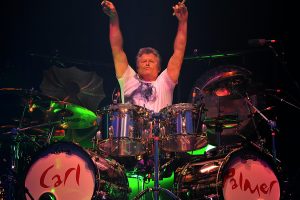 Can you explain to us the confusing story about your legendary stainless steel drum kit and Ringo Starr?
Can you explain to us the confusing story about your legendary stainless steel drum kit and Ringo Starr?
The stainless steel drum set was made in about ’72-’73 and the British Steel sponsored me and gave me the shells and helped me. Then, I put it together with a friend of mine, who is an engineer and I played it for approximately 7 years until the end of Emerson, Lake & Palmer. It was a great drum set. I couldn’t really transport it anymore because it was too heavy. It weighted approximately 560 kilos, which is ½ ton, which is the weight of a fighting bull. So, this was something very-very heavy and it became costly to move it around. When Emerson, Lake & Palmer finished at the end of the ‘70s, I decided I should have a fresh look at my equipment and actually have a fresh look at my drum set, exactly the way I set it up and what sizes I use, what make I use. So, I decided I really didn’t want it anymore and I had a call from Ringo Starr’s office or somebody made contact, I think he was his drum tech.
He said: “Ringo would like that”, I said: “Fine”. The drum set actually went into an auction, Bonhams Auction here in London and Ringo purchased it. Basically, they said: “If you want it to use Carl, we could always arrange it with you”. I had to explain to them that I didn’t want to use it anymore, that’s why I was selling it. Ringo Starr kept it for a number of years and then he sold it to a very-very good friend of mine called David Frangioni, who bought the drum set at the auction from Ringo. David Frangioni has bought other drum sets of mine and he is one of the biggest drum collectors in America. He has just published a book (ed: “Crash”) of famous drum sets: drum sets from the group Kiss to Yes, Deep Purple, Jimi Hendrix, Led Zeppelin, Emerson Lake & Palmer. The stainless steel drum set is on the front cover of his book, so it’s been a nice experience and I no longer wanted the drum set, but at least now it’s in a museum in Florida.
When you left Chris Farlowe to do an American tour with The Crazy World of Arthur Brown, you had to find your replacement. It’s a pity that few people know this story. Please continue.
This story basically is when I was with Chris Farlowe, I joined him when I was 15 years old. When I reached about 17½, nearly 18, I had an offer to join The Crazy World of Arthur Brown and they wanted me to go to America. Well, I had never been to America before and I had made same recordings with Arthur Brown and I decided that I went to see if I would leave Chris Farlowe & the Thunderbirds and go with Arthur Brown for this American tour. Chris Farlowe said: “Yes, you could leave, but you have to find a replacement drummer”. I said: “Ok, I will do that… And if I don’t like it with Arthur Brown, can I have my job back?” He said: “Yes, but you have to find a replacement drummer”. In Birmingham, whilst it’s the second biggest city in England, we all got to know each other very well people who play, because we all played in the same clubs, the same ballrooms and in the same situations. So, I met John Bonham when I was about 13-14 years old, so we became friends, we often played in the same club on the same night. When the opportunity came up for me to join Arthur Brown, Chris Farlowe said: “You have to find a replacement”, I thought it would be a good idea just to call John and say: “Would you like to come up?” John immediately said: “Yes!” and I think he stayed with Chris Farlowe for about 3 or 4 months and then he got a call from Robert Plant, because Robert Plant had been contacted by Jimmy Page to form the group Led Zeppelin and that’s how it happened.
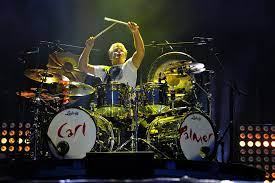 The second edition of your book “Art In Rhythm: The Artwork of Carl Palmer” is available on www.carlpalmerart.com . How important is this side of artistic expression for you?
The second edition of your book “Art In Rhythm: The Artwork of Carl Palmer” is available on www.carlpalmerart.com . How important is this side of artistic expression for you?
This expression started back in ’73, when I taped some light bulbs to my drumsticks and tried to take a photograph of it. If we go forward 40 years, the Chinese people started making drumsticks with lights in the end: LED lights. Yellow lights or blue lights or green or whatever you want. They have four prime colours. I decided to try these sticks again and I did. The result was very good, they are very good to play and they make very good reflections of light and shadows and movement of light. It was very-very good. When I saw a picture of it -I was in a dark room playing- when I saw this colour, this light moving around, it was very interesting. I actually have the first picture I took in ’73, when I couldn’t actually play the drums because the light bulbs would break, because they were just taped into the end of the drumstick, so I mimed. But with the new drumsticks that came out 40 years later, you could actually play the drums like you play normally. So, that’s what I decided to do, to try it again with a company called SceneFour and we do very-very well. I give 25-30% of the sale of every canvas to a local charity, whoever we decide on at the time. Sometimes we work with patrons and then they tell me they would like to give it to The Foundation for Cancer of America or The Heart Foundation of America or whatever. I ‘ve donated 25-30% and today we are into 6 years and we sold throughout the world about 600 canvasses.
Last year you received the “Prog God” award. What does this recognition mean to you?
It’s always nice to be recognized for what you ‘ve done. I took the award in honour of both Greg and Keith, because obviously without them, I wouldn’t have been where I am and possibly without me they wouldn’t be where they were. But at the end of the day, I think it was an award for all three of us. I was just the one that could collect it, so I’m very proud of it, it was a very nice thing to have and it made that year much nicer for me, because to lose Keith Emerson in March 2016 and then in December 2016 lose Greg Lake, it was quite a tragedy in my life. As you well know, in January 2017, John Wetton (ed: bass, vocals –King Crimson) died from the group Asia, that I play as well. It was a very tragic 11-month period for me, so having that award given to me, was really nice in this part of the healing process.
Was there any kind of competition in the ‘70s between you and Bill Bruford (Yes, King Crimson)?
No, I like Bill Bruford very much as a person. I thought he was a fantastic man. I thought his opinions and the way he did things were really-really good. He wasn’t a personal favourite of mine as a drummer and I never ever thought for one minute I was in competition with him and I doubt if Bill thought that he was ever in competition with me.
Why did you turn down an offer by Tony Iommi to join Black Sabbath?
Tony is a big friend of mine and I was just with him three days ago, having lunch. I didn’t turn it down, I wanted to do it. Tony’s management called me and asked me would I do it. I wanted to do it very much. I’ve always been a Black Sabbath fan because they are from Birmingham, the same town that I am and Tony has been a friend for many years. The problem was that Asia was about to go on tour and the Black Sabbath changed their recording dates, because Tony had the cancer and he had to go and have treatment and it meant that the album was put off for about 3-4 months. Well, those 3-4 months were difficult for me, because I was touring in America and I had to complete my Asia work. About the time I came back, I already had another tour which I had to do. So, I lost this period that I was free, because Tony couldn’t work and had to go into hospital and I’m pleased he did and when he came out and they wanted to start the album, I was already touring with Asia. So, it was a shame, it would be really nice. I would have enjoyed that.
Were you flattered by Buddy Rich’s statement that you are the most technically sounding drummer he had ever seen?
I thought that was very nice of him to say and that’s just his opinion. You know, maybe other people would say something different. But obviously, any statement that you get from such a magnificent musician as Buddy Rich, is always a very nice thing to say to you. So, I’m very grateful for the remark, but I still remain humble.
 What’s so special about Ringo’s drumming in “Ticket to Ride” (1965)?
What’s so special about Ringo’s drumming in “Ticket to Ride” (1965)?
It’s a very unique drum pattern that he plays. He plays it very-very well. I believe he didn’t actually come up with the idea, it was one of the other members. I think it might have been either McCartney or John Lennon. I’m not sure. But that particular pattern is very-very clever. It’s clever because it’s simple and because of its simplicity is one of my favourites that he has played and it’s one of favourite drum patterns. I enjoy listening to it and I actually used it once myself on an Asia track in a middle eight and John Wetton when he was alive said: “Oh, I’ve heard that! That’s from The Beatles!” and I said: “Yes”. He said: “Yes, let’s keep it in there, it’s great”. So, anyway that’s the story for you.
Is it possible to do an album with Steve Winwood in the near future?
If I had the opportunity to be in a group with Steve Winwood or play with him at any time, I would really enjoy that. I’ve always been a huge fan. Actually, many-many years ago we had a paper called The Melody Maker and The Melody Maker had a writer called Chris Welch. Chris Welch used to put supergroups together and say: “Wouldn’t it be nice if these people could be in a group together?” In one edition of the paper, he put in four supergroups he would like to see and I ended up in a group with Steve Winwood, believe it or not and Keith Emerson and myself and I forget who the fourth person was at the moment and I thought that was quite interesting to see that. Steve Winwood is from Birmingham too and I don’t think he actually knows it or might not remember, but I actually played with him one concert on a Saturday morning in a pub when I was 12 and I think he was about 15.
Do you think social media like Youtube and Facebook have helped younger listeners to learn about your music?
I think things like Facebook and Youtube have been fantastic! If you want to find something out, if you want to see a video and learn something about a musical instrument or anything, you can find it on Google, Youtube, Facebook. I think from that point of view, it’s been very-very good. Unfortunately, what this does because you can find out how Carl Palmer plays this or that, yes you can learn it, but what has happened is taking away some original approaches that people made while learning an instrument. When I was learning, I couldn’t go to Youtube because we didn’t have it, so I had to work out how to play things by myself. I became an individual player. Lots of players today sound the same because many of them watch the same videos time and time again, so they are slightly cloned. That’s not such a good point but the actual learning facility is absolutely superb and I think all those media are really good. In actual fact, once a month, I collect a lot of information throughout the month and I spend about two hours on Youtube listening to new groups, musicians, looking at products, looking at new drummers, looking at things that ‘ve been written about people on Youtube. I’ve made that a policy of mine for the last 10 years and I find it a great learning tool and one way of understanding exactly what is going on around me.
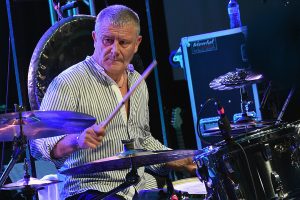 I have talked with another great drummer from Birmingham, Bev Bevan (ELO, The Move, Black Sabbath).
I have talked with another great drummer from Birmingham, Bev Bevan (ELO, The Move, Black Sabbath).
I know Bev Bevan very well. I will be with Bev Bevan next year (ed: 2019), April 11th. I will be playing a charity concert in Birmingham for The Children’s Hospital and Bev Bevan will be there.
Thank you very much.
Thank you so much for the interview. Have a great day. I must tell you that I really enjoy your country. I just came back from Cyprus, I was in Crete for a little while. I ‘ve been to Athens, I love Athens and the Peloponnese is just beautiful. Fantastic place.
I am calling from the Peloponnese.
Ah fantastic! The countryside is beautiful, is beautiful there. Thank you, take care. Geia sas, geia sas (ed: “Hello to you” in Greek)!
A huge “THANK YOU” to Mr Carl Palmer for his time.
Official Carl Palmer website: http://www.carlpalmer.com
Official Carl Palmer Facebook page: https://www.facebook.com/CarlFPalmer
Official Carl Palmer Art website: http://carlpalmerart.com


